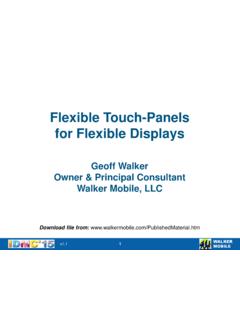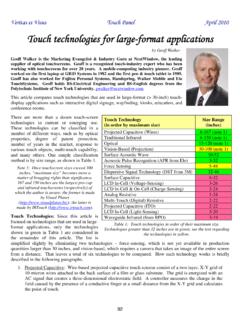Transcription of LCD In-Cell Touch - Walker Mobile, LLC - About Us
1 THE term In-Cell Touch generally refersto the implementation of a Touch sensor insidethe cell of a liquid - crystal display (LCD).While the term and technology have beenapplied to Touch sensors integrated intoplasma- display panels, electrophoretic (electronic paper) displays, and OLEDs, thisarticle examines only the application in LCDs. LCD In-Cell Touch currently exists in threeforms, only one of which is physically insidethe LCD cell. The three forms are as follows: In-Cell :The Touch sensor is physicallyinside the LCD cell.
2 The Touch sensorcan take the form of light-sensing ele-ments, micro-switches, or capacitiveelectrodes. On-cell:The Touch sensor is an X-Yarray of capacitive electrodes depositedon the top or bottom surface of the color-filter substrate. Strictly speaking, whenthe electrodes are on the bottom surfaceof the substrate they are physically insideLCD In-Cell Touch Imagine being able to Touch the surface of any display with your finger or a stylus and have the location of your Touch instantly identified down to the exact pixels.
3 Imagine this happening with no cover glass or special coatings or any other obstruction in front of the display , and with minimal change inside the display . That s the promise of In-Cell Touch . The problem is that the promise remains mostly out of reach. This article explores thatpromise and its current status in Geoff Walker and Mark FihnGeoff Walkeris the Marketing Evangelist &Industry Guru at NextWindow, the leading supplier of optical Touch screens. He is theGuest Editor for this issue of Information display , is a recognized Touch -industry expertwho has been working with Touch screens for20 years.
4 He can be reached at 408/506-7556and Mark Fihnis publisher of the Veritas et Visus newslet-ters, focused on the technologies and marketsrelated to flexible displays, display -relatedstandards and regulations, 3-D displays,high-performance displays, and touchscreens. He can be reached at 254/791-0603or display 3/100362-0972/03/2010-008$ + .00 SID 2010frontline technologyTable 1: The difficulty of integrating each of 11 Touch technologies as out-cell Touch is shown as green (easy), yellow (medium), and red (hard) Touch TechnologyDifficulty of Out-Cell IntegrationAnalog & Digital ResistiveNoneProjected CapacitiveNoneOpticalCameras & reflectors can be mounted on top of the LCDcell; no cover glass is requiredTraditional InfraredA PCB must surround the entire LCD.
5 No cover glass isrequiredSurface CapacitiveThe metal LCD frame cannot contact thetouch-screen glass and must be groundedSurface Acoustic WaveThe reflectors and transducers on the Touch -screen glassmust be protectedWaveguide Infrared (RPO)Waveguides and sensors must be mounted on the surfaceof the Touch -screen glass; IR LEDs must be attached tothe edge of the glassAcoustic Pulse Recognition Touch -screen mounting is critical(Elo TouchSystems)Dispersive Signal Technology (3M) Touch -screen mounting is criticalForce SensingTouch-screen mounting is criticalVision-Based OpticalNot applicable (rear-projection only)the cell but this is still usually called on-cell because of the type of elec-trodes.
6 (This is a good illustration of thefact that the terminology for In-Cell touchis still evolving.) Out-cell:This new term, coined in 2009by AU Optronics Corp., describes theconfiguration in which a standard touchscreen (usually only resistive or pro-jected capacitive) is laminated directlyon top of the LCD during module manu-facturing. Unlike the other two, this con-figuration typically requires an additionalpiece of glass even though it is techni-cally possible to use a film film resistivetouch screen in this these terms and the technologythat they describe are quite new, there is stillquite a bit of variation in their use in technicaland marketing documents.
7 Caution is advisedwhile reading any relevant material; on-cell may often be used to describe something thatis actually out-cell, and TouchOut-cell is basically just the integration of atouch solution at the LCD-module manufac-turer. This is not fundamentally different thanthe Touch integration that is often performedby third-party integrators today. The majordifference is that it is likely to be lower cost,which means that out-cell is probably going tobecome a general trend, one most likely tooccur with technologies that are easy to inte-grate.
8 Table 1 categorizes all current touchtechnologies in terms of the difficulty of integrating them as out-cell shown in Table 1, resistive and pro-jected-capacitive Touch screens are the mostlikely candidates for out-cell two most commonly used technologiesaccounted for over 95% of the total number oftouch screens shipped in 2009. Both are oftenattached to LCDs by third-party integrators,so it is easy for the LCD-module manufac-turer to do the same. Projected-capacitivesensors are increasingly being made on con-verted color-filter fab lines, so LCD manufac-turers have easy access to the technology.
9 Allof these factors are causing a number of well-known resistive and projected-capacitivetouch-screen manufacturers to begin to workclosely with major LCD manufacturers onout-cell integration. Among the other touchtechnologies, only optical seems to be gainingany acceptance from the LCD manufacturersin terms of out-cell and On-Cell Touch TechnologiesThere are currently three different Touch tech-nologies being used in In-Cell and on-celltouch. They are summarized as follows: Light Sensing ( In-Cell ):This technol-ogy, also called optical, uses the addi-tion of a photo-transistor into some or allof the LCD s pixels.
10 The screen can betouched with a finger, stylus, light-pen,or laser pointer. The Touch -sensing arraycan also be used as a scanner. A cover-glass can be used to protect the LCD ssurface. Voltage Sensing ( In-Cell ):This tech-nology, also called switch sensing, uses the addition of micro-switches for X and Y coordinates into each pixel orgroup of pixels. The screen can betouched with a finger or a stylus, withinthe damage limits of the LCD s cover-glass cannot be used to protectthe LCD s surface. Charge Sensing ( In-Cell ):This technol-ogy, also called pressed capacitive, uses variable-capacitor electrodes in eachpixel or group of pixels.




